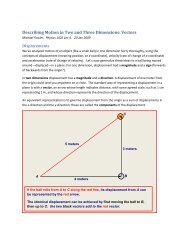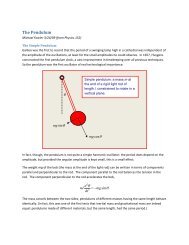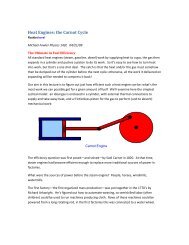Thermal Expansion Coefficients - Galileo and Einstein
Thermal Expansion Coefficients - Galileo and Einstein
Thermal Expansion Coefficients - Galileo and Einstein
- No tags were found...
Create successful ePaper yourself
Turn your PDF publications into a flip-book with our unique Google optimized e-Paper software.
2So 1 1 3 . But remember is very, very small—so even though 3 2 31 1 3 3 , the last two terms are completely negligible (check it out!) so to afantastically good approximation: 3 .The coefficient of volume expansion is just three times the coefficient of linear expansion.<strong>Thermal</strong> Properties of GasesIntroduction: First, Boyle’s LawEveryone knows that although water (like other liquids) is pretty much incompressible, air iscompressible—you can squeeze a small balloon to a noticeably smaller volume with your h<strong>and</strong>s, <strong>and</strong>you can push in a bicycle pump to some extent even if you block the end so no air escapes. Boyle wasthe first person to make a quantitative measurement of how the volume of a fixed amount of air wentdown as the pressure increased.MoveablepistonGasOne might imagine doing the experiment with gas in a cylinder as in the diagram here, putting ondifferent weights <strong>and</strong> measuring the volume of the gas. Once the piston is at rest, the pressure of thegas multiplied by the area of the piston would just balance the weight of the piston plus the addedweight, so the pressure is easy to find.But there is one tricky point here: if the gas is compressed fairly rapidly—such as by adding a substantialweight, so the piston goes down suddenly—the gas heats up. Then, as the heat escapes graduallythrough the walls of the cylinder, the gas gradually settles into an even smaller volume.














